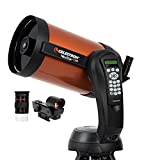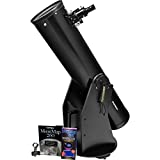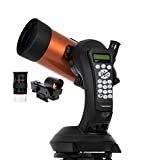Telescopes for viewing planets – Buying guide & Comparison
If you’re short on time and you just want to find the best telescope to see the planets, this short paragraph should help you get exactly the model you need. According to our research the Celestron NexStar 8 SE is the best because it is designed to be simple to setup and easy to use. It comes with SkyAlign technology so you can easily align the telescope with the three brightest objects in the night sky. Locating celestial bodies is also simple thanks to the “StarPointer” finderscope. It also comes with a long focal length so you can take advantage of high and low magnification. If the Orion Starblast isn’t available, your second option should be the Orion SkyQuest XT8.
Comparison table
 Our Top Choice
Our Top Choice
The optical components of this model are made out of top-notch materials which will ensure that the images you’ll be glancing at will be both crisp and clear. The quick-release mount setup that this unit has been outfitted with ca let you benefit from enhanced portability. The SkyAlign technology makes locating your favorite sky objects as easy as pie.
Several owners have complained about the battery life of this choice. Unfortunately, the device does have several limitations in this sense.
The value offered by the NexStar 8 SE is downright impressive, so you might have to consider this choice.
 2nd Best
2nd Best
The 8-inch aperture of this Dobsonian telescope is an advantage in itself as it will allow you to look at stars and planets and actually enjoy the clear view, for a change. The base is a breeze to align, so you’ll have no trouble tracking various celestial objects across the sky. The Starry Night software that accompanies the device can help you identify loads of objects.
Some buyers have reported that this Dobsonian telescope is considerably less lightweight compared to some of its competitors.
The Orion SkyQuest XT8 is an excellent model to give some thought to if you’re focused on performance.
Also To Consider
This Celestron alternative is equipped with everything you might need in a high-end telescope for looking at planets. Its mount, the Sky Align technology, as well as the 4-inch size will all enable you to get the most out of the product. The finderscope is a neat addition as it will allow you to discover any planet, star, or constellation. The software is part of the deal, as well.
Based on the user feedback we have come across, it appears that the finder scope is a tad tedious to align.
As a versatile, yet budget-friendly choice, the NexStar 4 SE might be a friend in need.
Telescopes can range dramatically in price, and this can make it difficult to know if you are getting the best value for your money. To help you make an informed decision we have created this easy to read buying guide. In it you will find the tips you need to confidently decide on what is the best telescope to see the planets and stars.
Optics
The best telescopes reviews agree that the most important aspect to consider are the optics. If it doesn’t come with high quality optics, you’ll quickly find that the telescope is a waste of your money. Since most telescopes come with interchangeable eyepieces magnification is rarely a problem, but this won’t matter if it doesn’t come with a large aperture. One tip to remember is to always choose a telescope with the largest aperture you can afford.
While the aperture is responsible for the amount of light gathered, the focal length determines whether the telescope is better suited for high or low powered magnification. Longer focal lengths are ideal if you want to clearly focus on single planets or distant double stars, and it is also more comfortable for eyeglass wearers to use. If you want to see wider views of the Milky Way you will want to choose a telescope with a shorter focal length. This also helps to limit the telescope’s overall weight. If you want to use high and low powered magnification look for a model that comes with a mid range focal length.
Mounts
The best home telescopes to see planets will come with an equatorial or altazimuth mount, and each has its own advantages. Equatorial mounts are generally considered easier to use, and are often recommended for beginners. Best of all some equatorial mounts are motorized so you can enjoy precise alignments and smooth tracking of objects across the sky. The downside to these mounts is that they can be priced a little higher.
Altazimuth mounts allow for manual aligning and tracking, though you can find a few higher priced models that are also motorized. Since you have to move the telescope in two directions simultaneously altazimuth mounts can be a little more difficult to use, especially if you are just starting out. The bonus is that these mounts are lighter in weight, and generally priced to fit most budgets.
Telescope accessories
The best cheap telescope to see the planets will still come with the accessories you need, and this often includes interchangeable eyepieces. This allows you to easily adjust the magnification, simply insert the correct eyepiece. Some inexpensive telescopes also come with a Barlow lens which can effectively double or triple the magnification. Models that come with finder scopes make it a little easier to find certain celestial objects. If you are just starting out a telescope that comes with a star chart or astronomical software will probably be a good value for you. When this is combined with the finder scope it can also make it a little easier for you to locate bright stars, planets and even constellations.
5 Best Planet Seeing Telescopes (Reviews) in 2024
If you know what to look for you can find a high quality telescope for viewing the planets and stars at home, without spending a lot of money. While we can’t choose the right model for you we can help you make an informed decision, which is why we have the best telescope to see the planets showcased below.
Contents
1. Celestron 11069 NexStar 8 SE Computerised Telescope

It comes with the company’s attractive trademark orange optics tube so this telescope is attractive and capable of giving you the performance you need.
The 8 inch optics are coated with “StarBright XLT” so you can enjoy crisp clear view at almost any magnification.
The “StarPointer” finder scope is aptly named, and when it is combined with the SkyAlign technology finding and locating celestial objects is a breeze. It also comes with Celestron’s expansive database that will clearly identify almost any object in the night sky.
Thanks to the “quick release” mount setup only takes a couple of minutes, and you’ll love the fact that you won’t need any additional tools.
Pros
This telescope is equipped with top-quality optics that deliver the highest useful magnification of 480X as well as the lowest magnification of 29X complemented with a 2032mm focal length, for a wonderfully clear resolution.
This is a light and portable telescope that enables the accurate locating of celestial objects minus the guesswork.
The StarPointer finderscope enables you to align the scope in the prime position for finding the perfect position for the instrument to view your favorite celestial object.
The SkyAlign feature enables you to use any three brilliant celestial objects as a reference point so you can perform fast and effortless alignment of the telescope.
You have a 40,000-object database at your disposal, with 200 user-definable objects along with a greater level of information on more than 200 objects.
Cons
Although the telescope runs on 8 double-A batteries, the power may not be sustainable enough to support extended observing when needed.
Buy from Amazon.com
2. Orion 08945e Black 29x Reflector Telescope

It comes with a wide 8 inch aperture that is capable of gathering enough light so you can clearly see nearby stars and planets, along with those at a distance.
Even nebulas and star cluster will appear bright and clear with the SkyQuest.
The Dobsonian base not only makes this telescope easy to align, it also allows for smooth tracking of moving objects across the sky. Since it provides a stable base for the telescope, you can set it up almost anywhere.
Though it should be noted that the SkyQuest is a little heavier than some similar models.
Thanks to the Starry Night software you can easily identify objects in the sky, and when this is combined with the EZ Finder II locating celestial objects is a breeze.
Pros
This large-aperture Classic Dobsonian reflector telescope allows you to view the Moon and the planets with amazingly fine detail and with enough capacity to gather light for clear images.
The ultra-stable Dobsonian base ensures a perfectly balanced optical tube assembly for effortless point-and-view functionality.
The 2-inch Crayford focuser accommodates 1.25-inch and 2-inch scope eyepieces to let you enjoy bright and vivid views of the objects in the deep sky.
The 8-inch aperture offers a large-enough parameter to capture as much light as possible from the celestial objects so you can enjoy clear and bright views every time.
The EZ Finder II reflex sight complements the collimation cap and the 25mm Sirius Plossl eyepiece for problem-free focusing, alignment, and viewing.
Cons
Customers ought to check that everything stated to come in the package is there so as to avoid any issues arising from missing components.
Buy from Amazon.com
3. Celestron 11049 NexStar 4 SE Computerised Telescope

The attractive orange optics tube ensures that you know this telescope is from Celestron, and this also assures you that you are purchasing a quality product. It also comes with a fork arm mount for a quick and easy tool free setup.
Since the optics come with “StarBright XLT” high transmission coatings distant planets, stars and even galaxies will appear bright and clearly defined.
You also have the advantage of SkyAlign technology so all you have to do is align the telescope on any 3 bright celestial objects.
When this is combined with the finderscope you can easily locate almost any star, planet or constellation. To ensure you always know exactly what you are viewing the NexStar comes with Celestron’s expansive astronomy software.
Pros
This Maksutov-Cassegrain telescope features StarBright XLT high-transmission coatings that enable the critical optical elements to collect as much light as possible from celestial objects in order for them to deliver bright and crisp images.
The StarPointer finderscope helps with the alignment of the scope so you can locate objects with accuracy and eliminate the guesswork.
The quick-release fork arm mount provides easy and quick attachment to a good-quality tripod so you can view objects with enough support.
The SkyAlign feature enables you to align the scope on any three brilliant objects in the deep sky so you can proceed to view your target immediately.
The scope provides access to an enormous database of 40,000 objects that features 200 user-definable objects along with more information on more than 200 other objects.
Cons
The unit does not ship with rechargeable batteries and its small size might limit the viewing of deep-sky objects but just enough for less intensive studies.
Buy from Amazon.com
4. Carson Red Planet 50-100x90mm Refractor Telescope For Astronomy

This refractor telescope comes with a large 90mm aperture that ensures plenty of light is gathered for viewing distant stars and planets.
It also comes with a 1000mm focal length which is ideal for use with high magnification, and makes the telescope comfortable for eyeglass wearers to use.
The equatorial mount ensures easy and precise alignment, and allows for smooth tracking and scanning. The finderscope makes it a little easier to locate stars and planets, especially when you take advantage of the settings for longitude and latitude.
The aluminum tripod can be adjusted for height, and provides a steady base for the telescope. It also adds to the telescope’s sleek and stylish design that ensures it looks great sitting out in your house.
Pros
This refractor telescope is equipped with exceptional, fully-coated optics, which means all air-to-glass surfaces are coated to reduce reflected light and ensure complete light transmission.
The heavy-duty aluminum tripod comes with an equatorial mount to reduce the shaking and movements when viewing celestial objects earnestly.
The setting circles enable you to simply dial in the coordinates much like setting the longitude and latitude to search for specific stars, constellations, and planets.
The 6x30mm finder scope works well with the two high-quality eyepieces so you can locate the celestial target and enjoy clear and vivid views every time.
The sleek and sophisticated design makes the telescope worthy to be displayed the whole year round because of how it blends nicely with the decor.
Cons
One customer was disappointed with the way the product was packaged although this did not diminish the quality of the scope and the included elements in the set.
Buy from Amazon.com
5. Orion 09007 SpaceProbe 130ST Equatorial Reflector Telescope

Not only does it come with powerful optics, it is also priced to fit most consumers’ budgets.
It is also incredibly easy to set up, and since it only weighs 27 pounds portability isn’t a problem.
The 5.1 inch aperture ensures that there is plenty of light so you can clearly see planets, stars, nebulas and distant galaxies.
The finder scope and Starry Night software make it easy to locate and identify celestial objects, especially when it is combined with the smooth tracking you get with the equatorial mount. This also makes alignment a breeze.
Pros
Suitable for the more serious intermediate and beginner astronomer, this telescope features a 130mm parabolic primary mirror that gathers a great amount of light to deliver crisp and clear images.
The precise and sturdy EQ-2 equatorial mount features slow-motion hand controls and dual setting circles for easy tracking of celestial objects as they move across the night sky.
The included height-adjustable aluminum tripod provides support to the telescope during use so your hands free to work the controls and make adjustments.
You just need to do a simple polar alignment procedure and then use the mount to track deep-sky objects as they move across the sky.
The accessory tray holds the critical optical components so you have them always handy and within easy reach every time.
Cons
The nomenclature of parts in the instruction booklet does not match the directions for assembly but it takes a simple understanding of what goes on which to put the scope together properly.
Buy from Amazon.com











